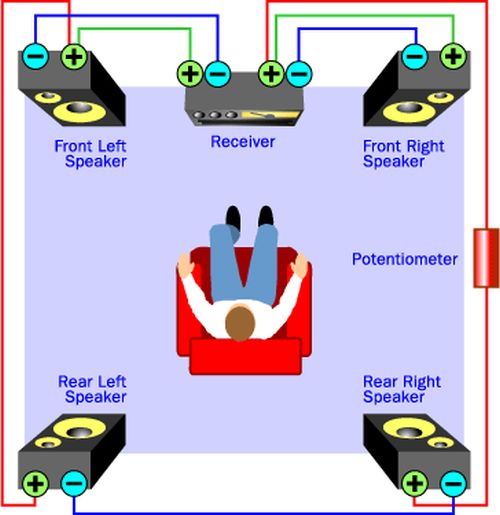What is Surround Sound?
There are many ways to make and present a sound recording. The simplest method, and the one used in the earliest sound movies, is called monaural or simply mono. Mono means that all the sound is recorded onto one audio track or channel (a single spiraled groove in a record, for example, or a single magnetic track on tape), which is typically played on one speaker.
Two-channel recordings, in which sound is played on speakers on either side of the listener, are often referred to as stereo. This isn’t entirely accurate, as stereo (or stereophonic) actual refers to a wider range of multi-channel recordings. Two-channel sound is the standard format for home stereo receivers, television and FM radio broadcasts. The simplest two-channel recordings, known as binaural recordings, are produced with two microphones set up at a live event (a concert for example) to take the place of a human’s two ears. When you listen to these two channels on separate speakers, it recreates the experience of being present at the event.
Surround recordings take this idea a step further, adding more audio channels so sound comes from three or more directions. While the term “surround sound” technically refers to specific multi-channel systems designed by Dolby Laboratories, it is more commonly used as a generic term for theater and home theater multi-channel sound systems. In this article, we’ll use it in this generic sense.
There are special microphones that will record surround sound (by picking up sound in three or more directions), but this is not the standard way to produce a surround soundtrack. Almost all movie surround soundtracks are created in a mixing studio. Sound editors and mixers take a number of different audio recordings — dialogue recorded on the movie set, sound effects recorded in a dubbing studio or created on a computer, a musical score — and decide which audio channel or channels to put them on.
In the next section, we’ll learn a little bit about how surround sound was created and see how it was configured in older theaters.
Early Surround
Over the years, there have been many different approaches to surround sound. Walt Disney’s “Fantasia” (1941), one of the earliest surround-sound movies, immersed the audiences in classical music. Disney sound engineer William Garity took separate recordings of each orchestra section and mixed them to produce four distinct audio tracks, which were recorded as optical tracks on a separate reel of film.
The four tracks drove different speakers positioned around the theater. In an equipped theater, the music seemed to move around the auditorium, an effect achieved by sound panning. Panning involves fading a sound (a violin melody, for example) from one audio channel while building it on another.
To show “Fantasia” in surround sound, a theater needed an additional projector to play just the soundtrack, as well as an expensive receiver and speaker assembly. (Check out Film Sound History for a thorough history of how “Fantasound” came about.)
This surround-sound system didn’t catch on (the necessary equipment was prohibitively expensive), but by the late 1950s, many Hollywood movies were encoded with simpler multi-channel formats. Several different theater setups emerged in this era, including the famous Cinerama and Cinemascope, but most of them used the same basic sound technology. As a whole, these systems were referred to as stereophonic sound, or simply theater stereo.
For more detail: How Surround Sound Works

